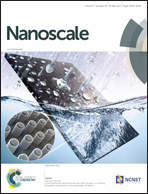Graded nanowell arrays: a fine plasmonic “library” with an adjustable spectral range†
Abstract
We present an effective approach for fabricating graded plasmonic arrays based on ordered micro-/nanostructures with a geometric gradient. Ag nanowell arrays with graded geometric parameters were fabricated and systematically investigated. The order of the graded plasmonic arrays is generated by colloidal lithography, while the geometric gradient is the result of inclined reactive ion etching. The surface plasmon resonance (SPR) peaks were measured at different positions, which move gradually along the Ag nanowell arrays with a geometric gradient. Such micro-/nanostructure arrays with graded and integrated SPR peaks can work as a fine plasmonic “library” (FPL), and the spectral range can be controlled using a “coarse adjustment knob” (lattice constant) and a “fine adjustment knob” (pore diameter). Additionally, the spectral resolution of the FPL is high, which benefits from the high value of the full height/full width at half-maximum and the small step size of the wavelength shift (0.5 nm). Meanwhile, the FPL could be effectively applied as a well-defined model to verify the plasmonic enhancement in surface enhanced Raman scattering. As the FPL is an integrated optical material with graded individual SPR peaks, it can not only be a theoretical model for fundamental research, but also has great potential in high-throughput screening of optical materials, multiplex sensors, etc.



 Please wait while we load your content...
Please wait while we load your content...